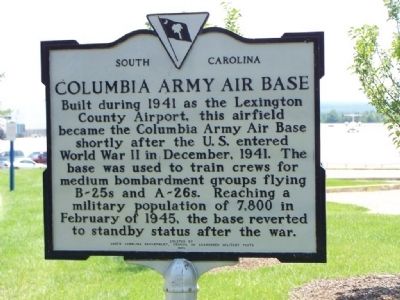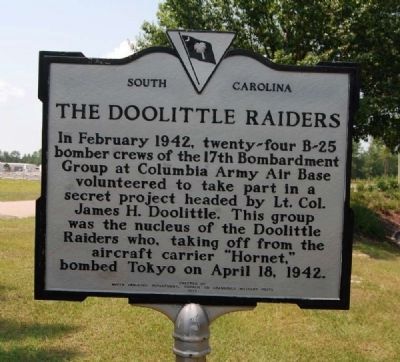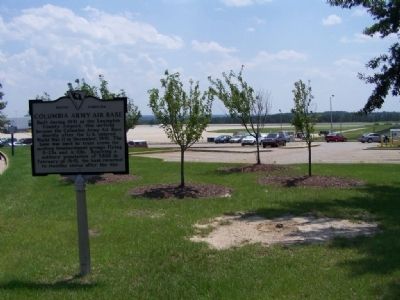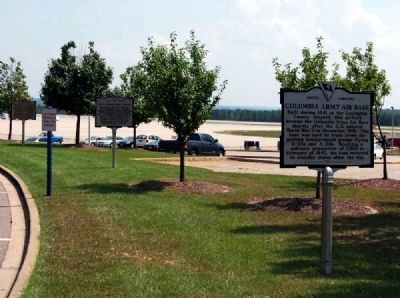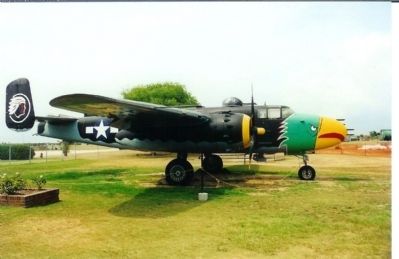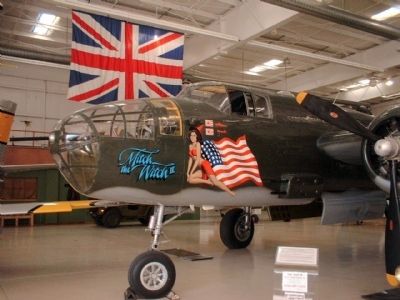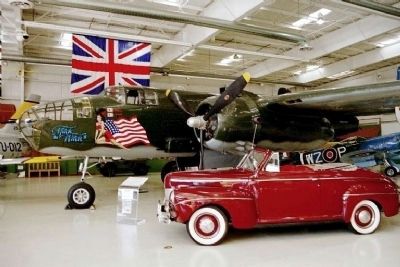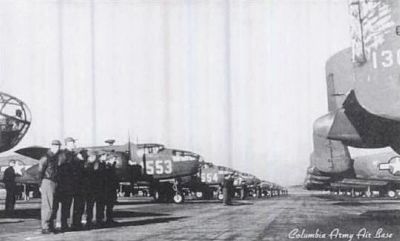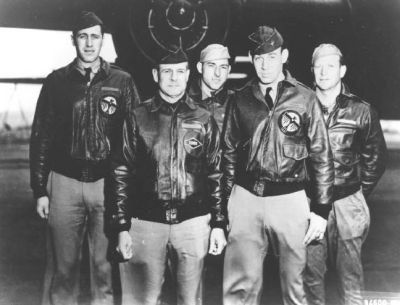West Columbia in Lexington County, South Carolina — The American South (South Atlantic)
Columbia Army Air Base / The Doolittle Raiders
Erected 1979 by South Carolina Department, Council on Abandoned Military Posts. (Marker Number 32-13.)
Topics. This historical marker is listed in these topic lists: Air & Space • War, World II. A significant historical month for this entry is February 1945.
Location. 33° 56.867′ N, 81° 7.686′ W. Marker is in West Columbia, South Carolina, in Lexington County. Marker is on Airport Boulevard near Air Commerce Road, on the right when traveling east. At Columbia Metropolitan Airport. Touch for map. Marker is in this post office area: West Columbia SC 29170, United States of America. Touch for directions.
Other nearby markers. At least 10 other markers are within 4 miles of this marker, measured as the crow flies. 319th Bombardment Group (a few steps from this marker); Bombardment Groups (within shouting distance of this marker); 345th Bombardment Group (within shouting distance of this marker); Springdale (approx. 1.3 miles away); Camp Moore (approx. 2.8 miles away); The Sycamore Tree (approx. 2.9 miles away); Congaree Fort (approx. 3 miles away); The Cherokee Path (approx. 3.3 miles away); Mt. Hebron United Methodist Church / Temperance Hall (approx. 3˝ miles away); Emily Geiger (approx. 3.8 miles away). Touch for a list and map of all markers in West Columbia.
Also see . . .
1. Columbia Metropolitan Airport. Columbia Metropolitan Airport (IATA: CAE, ICAO: KCAE, FAA LID: CAE) is the main airport for Columbia, South Carolina, located in the suburb of West Columbia. (Submitted on August 15, 2009, by Brian Scott of Anderson, South Carolina.)
2. Doolittle Raiders.com. The official website of the Doolittle Raiders. (Submitted on August 15, 2009, by Brian Scott of Anderson, South Carolina.)
3. Doolittle Raid. The Doolittle Raid, 18 April 1942, was the first air raid by the United States to strike a Japanese home island (Honshū) during World War II. (Submitted on August 15, 2009, by Brian Scott of Anderson, South Carolina.)
4. The FReeper Foxhole Profiles General "Jimmy" Doolittle. Doolittle was one of the pioneers of instrument flying and of advanced technology, while also being an outstanding combat leader, commanding the Twelfth, Fifteenth, and Eighth Air Forces during World War II. (Submitted on August 15, 2009, by Brian Scott of Anderson, South Carolina.)
5. James Doolittle, 96, Pioneer Aviator Who Led First Raid on Japan, Dies. James H. Doolittle, an aviation pioneer and a retired lieutenant general in the Air Force who led the daylight air raid on Tokyo and other Japanese cities four months after the Japanese attacked Pearl Harbor, died yesterday at the age of 96. (Submitted on August 15, 2009, by Brian Scott of Anderson, South Carolina.)
6. The Doolittle Tokyo Raiders Photos. Here are some photos from before, during and after the Doolittle Raid. (Submitted on August 16, 2009, by Brian Scott of Anderson, South Carolina.)
7. USS Hornet (CV-8). USS Hornet (CV-8) of the United States Navy was a Yorktown-class aircraft carrier of World War II, notable for launching the Doolittle Raid, as a participant in the Battle of Midway, and for action in the Solomon Islands before being irreparably damaged and sunk in the Battle of the Santa Cruz Islands. (Submitted on August 16, 2009, by Brian Scott of Anderson, South Carolina.)
Additional commentary.
1. Doolittle Raiders Recall 30 Seconds in History
New York Times
April 16, 1992
Fifty years ago Jimmy Doolittle, then a lieutenant colonel in the Army Air Forces, flew to a small air base south of here seeking volunteers for a World War II mission that he described only as top secret and extremely hazardous.
Nearly 140 men base volunteered, and 80 of those were selected. Their mission: bomb Tokyo.
It was daring and seemingly suicidal. The five-man crews, aboard 16 heavily loaded B-25 bombers, were to take off from an aircraft carrier 450 miles from their target, knowing there was no turning back. The bombers could not land on the carrier; instead, after dropping their bombs they were to continue on, hoping to land at two primitive landing strips in Chinese territory that was not controlled by the Japanese.
On April 18, 1942 -- four months and 11 days after the Japanese attack on Pearl Harbor -- Colonel Doolittle's Raiders accomplished their mission.
Flying low, they approached Japan undetected and dropped 16 tons of bombs on factories and military installations in Tokyo and four other cities. The bombs caused little material damage, but they sent shock waves through Japan and lifted the morale of a dispirited America.
Somehow,
73 of the 80 crew members survived that historic mission. And on Thursday, 36 of the 40 who are still living will, for the first time, return to Columbia to commemorate the 50th anniversary of the raid. Their leader, who was promoted to general and awarded the Medal of Honor for the raid on Japan, is now 95 years old and living in Monterey, Calif. But he is unable to attend the three-day celebration.
Since World War II ended, the Raiders have met every year except one, said Brig. Gen. Richard Knobloch of San Antonio, the chairman of the Doolittle Tokyo Raiders Association.
As with all extraordinary events, the raid serves as the defining moment of their lives. They were young and, as one of the navigator-bombardiers, James Macia of San Antonio, said, "full of spit and vinegar."
They had been at the Columbia Army Air Base only two weeks when Colonel Doolittle sought their help. Few remember much about this city, but they did know the colonel, who had been a World War I flier and had a reputation as a daredevil.
Colonel Doolittle was counting on surprise. He knew the Japanese felt secure from an air attack because Japan was beyond the range of Army bombers.
"The old man," as his raiders call him, also knew that a B-25 could do the job from a Navy carrier. But his plans went askew on the rainy morning of April 18 when, some 800 miles at
sea, a Japanese boat was spotted. The Americans sank the boat, but they did not know whether their whereabouts had been reported. The mission was quickly launched, but the Raiders knew they lacked the fuel to get to the landing strips in China.
They took off from the carrier Hornet at 8 A.M., hit their targets about noon and soared away to the west. They flew for nine hours more, but as the fuel tanks emptied, the crews of 11 of the planes parachuted out. Four other planes crash-landed near the Chinese coast, killing four crewmen, and the remaining plane landed in Vladivostok, Siberia.
Seven crewmen who parachuted out over Japanese-occupied China were captured, and three of them were executed. They were William G. Farrow, of Darlington, S.C.; Dean E. Hallmark, of Robert Lee, Tex., and Harold Spatz, of Lebo, Kan.
Columbia and local businesses have planned and paid for the $115,000 Raiders celebration, which includes a state dinner, a ball, an exhibit at the South Carolina State Museum and the premiere of a play about the raid.
But the raid has already been documented in the 1943 movie "Thirty Seconds Over Tokyo," which was based on the book by Ted Lawson, a pilot who died earlier this year.
"I would do anything for these guys," said Marvin Chernoff, whose Columbia-based advertising and public relations firm coordinated the reunion. "I got very emotional the first time I met them. I'm told in '42 they were crazy, and they're crazy now. They are a great bunch of guys."
— Submitted August 16, 2009, by Brian Scott of Anderson, South Carolina.
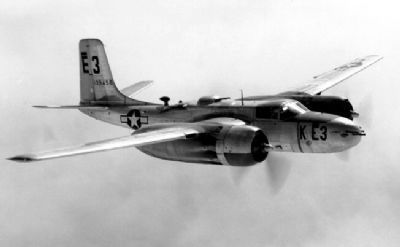
8. A-26 Bomber
The Douglas A-26 Invader, a twin-engine attack / medium bomber aircraft, went into service in the spring of 1944 and served in both the European and Pacific theatres of World War II. In the post-war U.S. Air Force the "A" for attack designator was changed to "B" for bomber, making this aircraft the B-26. Variants were still in service as late as the Vietnam War.
[Source: U.S. Air Force official photograph]
[Source: U.S. Air Force official photograph]
Credits. This page was last revised on January 13, 2024. It was originally submitted on August 24, 2008, by Mike Stroud of Bluffton, South Carolina. This page has been viewed 4,781 times since then and 57 times this year. Photos: 1. submitted on August 24, 2008, by Mike Stroud of Bluffton, South Carolina. 2. submitted on August 15, 2009, by Brian Scott of Anderson, South Carolina. 3. submitted on August 24, 2008, by Mike Stroud of Bluffton, South Carolina. 4. submitted on August 16, 2009, by Brian Scott of Anderson, South Carolina. 5, 6, 7, 8. submitted on August 26, 2008, by Mike Stroud of Bluffton, South Carolina. 9. submitted on August 15, 2009, by Brian Scott of Anderson, South Carolina. 10. submitted on August 16, 2009, by Brian Scott of Anderson, South Carolina. • Craig Swain was the editor who published this page.
